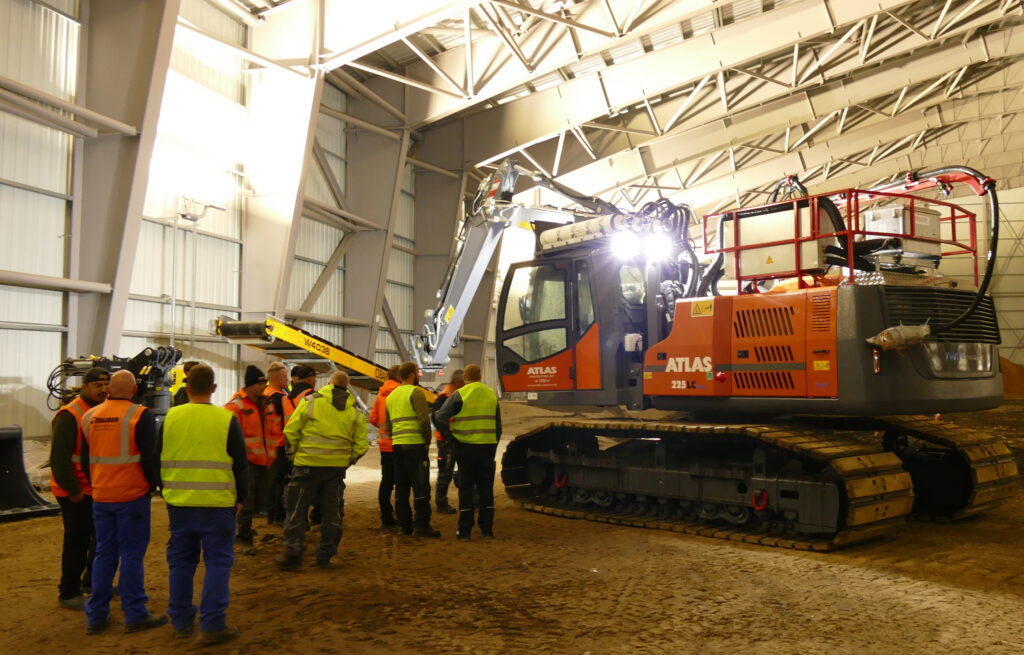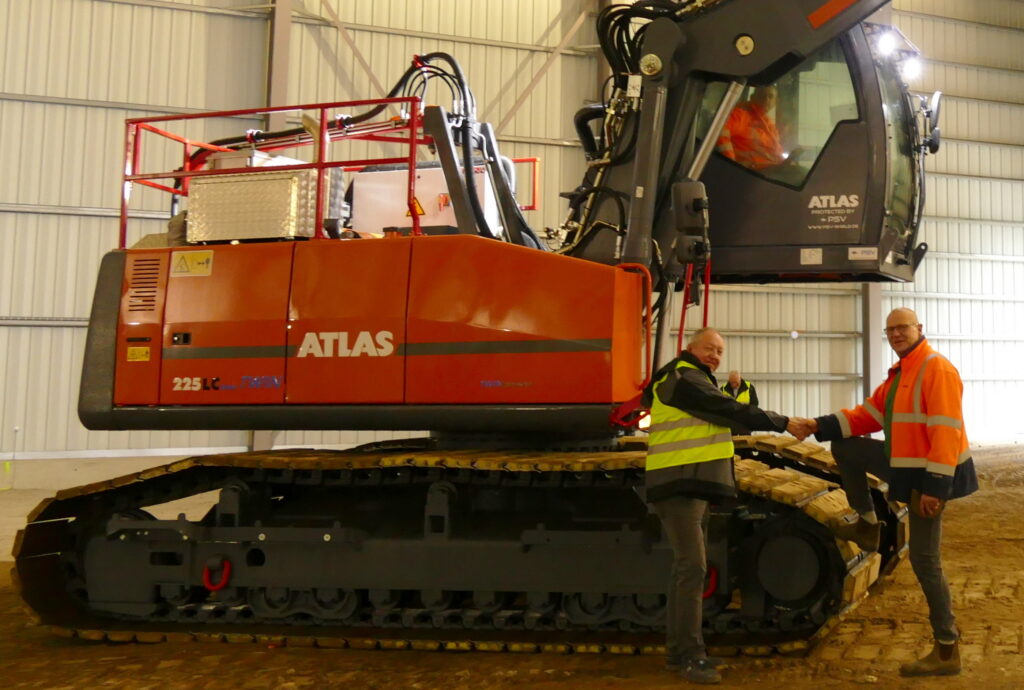ATLAS excavator 225 LC converted especially for munitions clean-up – electric and diesel drive – inert gas equipment – featuring highly receptive sensors
The special equipment that the ATLAS 225 LC chain excavator needs to be able to perform the dangerous clean-up of munitions in the Dethlinger pond weighs six tonnes. Rather than 23.5 tonnes, the 225 LC now weighs 29.5 tonnes.The TWIN Power drive features a standard diesel engine and a 130-kW electric motor. What is ingenious is the solution of installing it in the recessed counterweight. It is supplied via an 85 m long cable for 400 volts with 400 amps. This is routed via a support arm at the rear.
Similar to the Leopard 2 – all-round protection
As part of the extensive tender, it was stipulated that the excavator must fulfil the safety requirements of STANAG Level II. In practical terms, this means that the front windscreen of the cab is protected with 56 mm armoured glass and the side windows with 50 mm armoured glass. All windows can be heated. Six mm armoured steel is also installed under the cab. The door weighs approx. 250 kg and is operated electrically. The cab is completely sealed and features protective ventilation with three compressed air cylinders mounted on the roof. The sensors for detecting the presence of poisonous gas are also located there. The protective ventilation is activated immediately in the event of an emergency thanks to a signal from the sensors. It is possible to make an emergency exit through the rear of the cab.
Extensive and complex clean-up
The German Armed Forces and later the British Army disposed of a huge number of grenades, including those filled with chemical warfare agents, in the Dethlinger pond, a former diatomaceous earth pit near Munster, from 1942 to 1952. The small pond measured 63 m wide and was around 12 m deep. The pit was backfilled with soil and rubble in 1952. Rotting set in over time, combined with groundwater contamination. The Heidekreis district, which is responsible for the site, launched the initial plans for the clean-up in 2014. The pit was opened in 2021 with a test shaft revealing several thousand pieces of ammunition. Experts have now developed a clean-up concept. Plans envisage a clean-up period of around six years. A 97 m x 106 m hall was erected above the pond. It has a self-supporting roof with a ridge height of 20 m and rests on a concrete foundation and 22 m of sheet piling underneath. The clean-up involves permanently extracting air from the hall and filtering it with activated carbon. That’s around 200,000 m³ per hour. The groundwater is also collected and purified. The large hall is totally sealed and can only be left through airlocks with subsequent decontamination. Other halls, for example for purifying the groundwater or sanitising personnel, have also been provided. An emergency doctor and an ambulance are also on site during daily operations. The employees of the clean-up team are only allowed to work in the pit using special equipment and for short periods of time. The total cost of the clean-up is estimated at over € 60 million.
Active clean-up has now begun. This means that the Atlas armoured excavator is also in use. The excavated material is transported into containers via conveyor belts. An air-lock system is used to remove these containers. The munitions found are taken to a specialised facility in Munster. They are then incinerated at 1,800° in a special furnace.
High outlay for the special excavator
“The tender for the special excavator was extremely demanding and complicated. But we succeeded in designing and building a machine that is one of a kind in the world,” says Ronald Figiel, project manager for this at the Atlas von der Wehl dealer. It was also here that the entire development and implementation was overseen. Everything was based on the ATLAS 225 LC crawler excavator. Originally a 23-tonne excavator with a 129 kW/175 hp EU Stage 5 engine. This basic machine has been made ultra-safe as described. A number of different companies were involved in the process. One of these was the company ATLAS Kern, which implemented the conversion for the electric drive.
Ultimate principle: safety
Full concentration and maximum attention are required during work. To achieve this, the cab can be elevated 1,000 mm and tilted backwards. This provides a better view of the working area. The heavy weight of the cab made it necessary to reinforce all parts. The radio has been removed so that the driver is not distracted. The fully hydraulic quick coupler can be used with various buckets, clamshell grabs or gravel suckers. The undercarriage has been extended from 4,500 cm to 5,000 cm to ensure that the ATLAS excavator can work safely on soft ground. Three-bar floor plates with a coating and a width of 100 cm are also installed. In the event that the excavator does break down, a wheel loader is available that is capable of keeping the excavator moving by means of emergency hydraulics using 15 m long hydraulic hoses. The ATLAS excavator has now been driven into the hall that stands above the Dethlinger pond. It will not leave the hall until the clean-up is complete.
Characters: 4,407
Photos: The ATLAS 225 LC with special equipment drives into the hall above the Dethlinger pond. It will leave again when the clean-up is complete.
Photo 2: Familiarisation with the special ATLAS 225 LC took place on site before the clean-up work began.
Photo 3: Ronald Figiel (Atlas von der Wehl) and Carsten Bubke (Technical Manager Heidekreis) from the left during the excavator handover.


